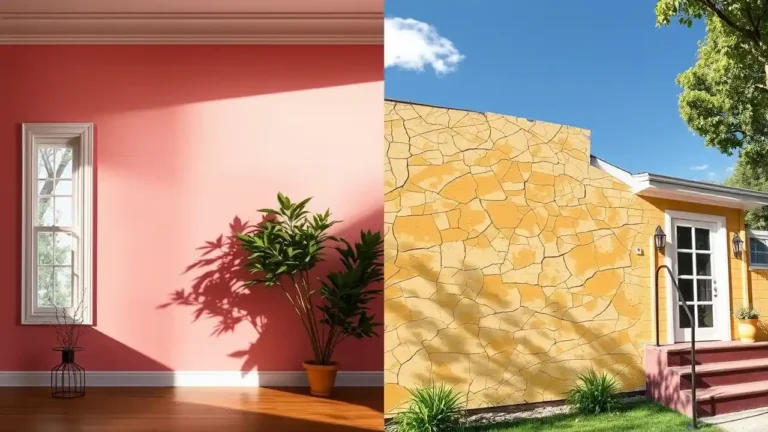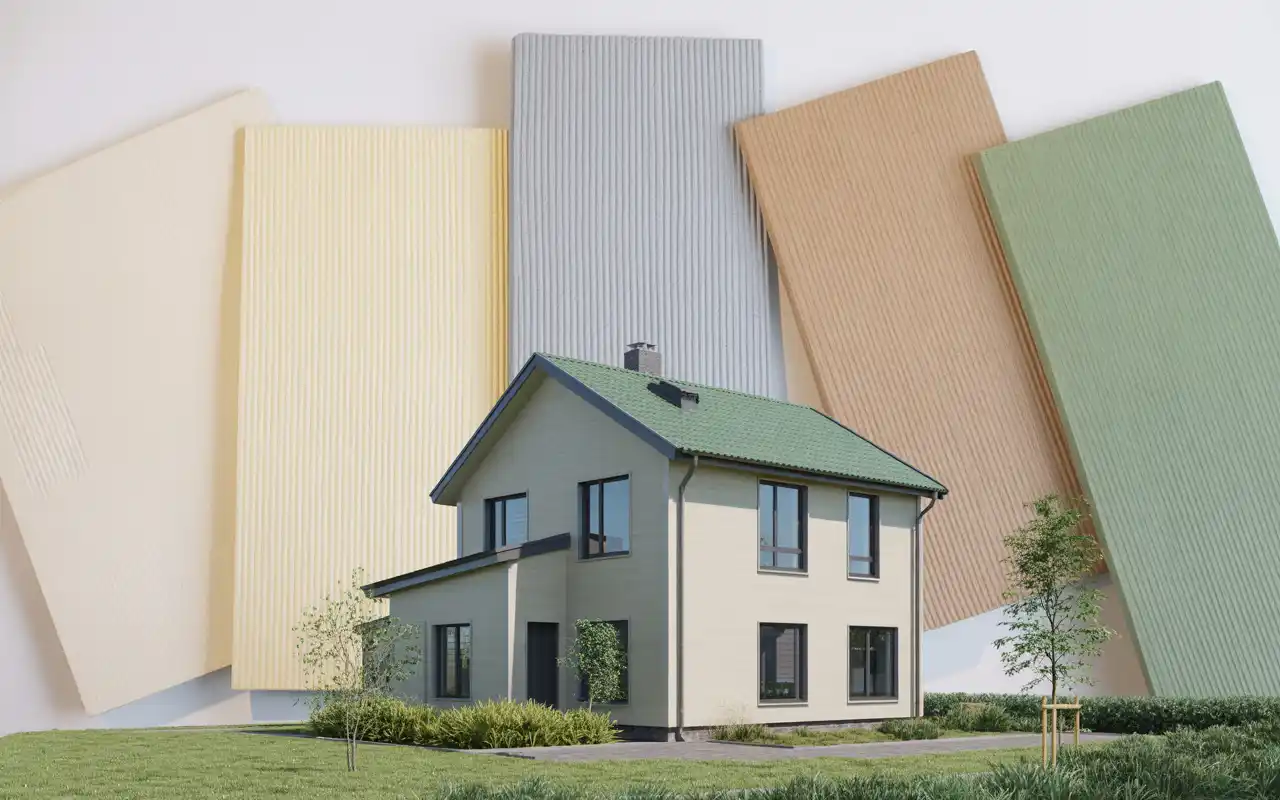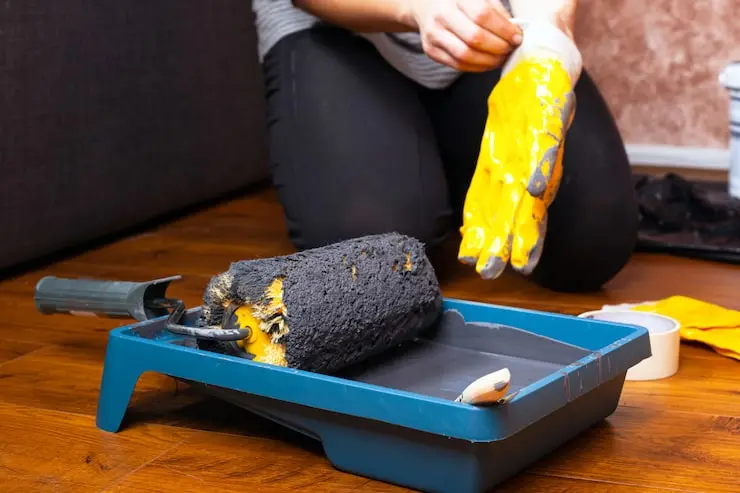The question is a common one when you have leftover paint in the garage: Can Interior Paint Be Used Outside?
The direct and expert answer is a clear No, you should never use interior paint for an exterior project. This decision will guarantee premature failure, leading to peeling, cracking, and a more expensive repair job than simply buying the correct product in the first place. This guide explains why, detailing the chemical differences and offering a professional perspective on why it’s a risk not worth taking.
Table of Contents
Interior vs. Exterior Paint: What's the Difference?
To understand why using interior paint outdoors is a mistake, you must first know that interior and exterior paint are formulated for fundamentally different environments. Paint is not just color; it’s a sophisticated chemical system of pigments, binders, and liquid designed to protect the surface from its specific threats.
The differences are mainly categorized by the binder (resin) and the specific additives used:
Feature | Interior Paint Formula | Exterior Paint Formula | Why It Matters |
Primary Binder | Rigid, often Vinyl Acrylic or lower-grade acrylics. | Flexible, high-quality 100% Acrylic or Oil-based paint. | The difference between resisting scuffs (interior) and resisting temperature swings (expand and contract) (exterior). |
UV Resistance | Low to none. Pigments often use organic compounds that fade easily. | High-quality, stable pigments and UV blockers to prevent fading and chalking from UV rays. | Protects color and prevents the binder from degrading under direct sunlight. |
Moisture/Mold | Minimal mildewides (due to indoor air quality concerns). | High concentration of Biocides, Fungicides, and Mildewcides to fight mold and algae. | Prevents biological growth from outdoor weather conditions. |
VOCs & Odor | Lower levels of volatile organic compounds (VOCs) for safe indoor air quality. | Historically higher VOCs (though this is changing) due to necessary strong solvents and additives. | Exterior paint contains chemicals not safe for enclosed indoor spaces. |
The Core Chemistry: Resins and Flexibility
The most critical factor is the binder, or resin.
- Interior Paint utilizes a harder, more brittle binder, often Vinyl Acrylic. This hardness is excellent for abrasion resistance, meaning it stands up to scrubbing and everyday knocks without marking.
- Exterior Paint uses flexible 100% Acrylic resins. This flexibility is essential because exterior surfaces (wood, stucco, concrete) constantly change size due to temperature and humidity. The paint film must be able to expand and contract with the surface. If it can’t, it breaks.
Can You Use Interior Paint Outside?

Technically, yes. You can apply interior paint to outdoor surfaces. But it’s a terrible idea that will cost you more than buying proper outdoor paint.
I’ve seen this mistake dozens of times. Last year, a client painted their deck with leftover bedroom paint. It looked fine for about ten days. Then cracks appeared. By week six, large sections were peeling off in sheets. The wood underneath had absorbed moisture and started to rot.
The repair cost $1,800. The proper exterior paint would have cost $120.
Why Homeowners Try This
I understand the temptation. Paint is expensive. If you have three gallons sitting in your garage, using it seems smart. But what happens if you use interior paint outside isn’t pretty.
You’re not saving money. You’re delaying an inevitable expense and making it worse.
Can You Use Exterior Paint Indoors?
Don’t do this either. While exterior paint is more durable, it’s not designed for indoor use.
Problems with using exterior paint indoors:
High VOC levels create strong fumes. These don’t dissipate quickly in enclosed spaces. You’ll smell paint for weeks, not days. Some people experience headaches, dizziness, or respiratory issues from prolonged exposure.
The finish is rougher too. Exterior paint is made to stick to stucco, brick, and rough wood. On smooth interior walls, it looks textured and uneven.
There’s one exception: garages and covered patios that are semi-outdoor spaces. Here, exterior paint makes sense because these areas face some weather exposure.
What Happens if I Use Interior Paint Outside?

Let me walk you through the actual timeline of failure. I’ve documented this on several projects where homeowners tried using interior paint outdoors.
Week 1-2: The False Hope Period
Everything looks great. The paint goes on smoothly. Colors look vibrant. You think you made a smart choice. This is when homeowners tell their neighbors about their “money-saving trick.”
Week 3-4: Early Warning Signs
Colors start looking dull, especially reds and blues. Up close, you’ll see tiny hairline cracks forming. Most people don’t notice these yet. In coastal areas near the ocean, this happens faster because of salt air and moisture.
Week 5-8: Visible Problems
The paint loses its sheen completely. Cracks become obvious from a few feet away. Edges and seams start lifting. If you press on bubbling areas, they feel spongy. Water has already gotten underneath.
Week 9-12: Major Failure
Large sections peel away. You can pull off hand-sized pieces of paint. The surface underneath is exposed to weather. Wood may show water damage. Stucco might have efflorescence (white powder from salt deposits).
Month 4 and Beyond: Complete Breakdown
Eventually peeling becomes severe. Mold and mildew grow in damp spots. The substrate itself is now damaged. What started as a painting project is now a repair project.
Real Cost Comparison:
Initial cost using interior paint: $80 (2 gallons) Cost to fix after failure:
- Paint removal: $400-600
- Surface repair: $300-800
- Proper exterior paint: $120
- Labor (now you need a pro): $800-1,200
Total repair cost: $1,620-2,720
You “saved” $40 but spent $2,000 fixing the problem.
Best Practices: Choosing the Right Paint for Your Project
The right paint choice depends on what you’re painting and where you live.
For Most Exterior Surfaces
100% Acrylic Latex Paint
This is your best choice for most outdoor projects. It’s flexible, durable, and resists fading. Water based paint in this category is easier to clean up than oil based paint options.
Look for brands like Sherwin-Williams Duration or Benjamin Moore Aura Exterior. These cost $70-85 per gallon but last 10-15 years with proper prep.
For Wood Surfaces
Solid Stain or Acrylic Paint
Wood siding, decks, and fences need paint that penetrates and breathes. Benjamin Moore ARBORCOAT is excellent for wood. It lets moisture escape while blocking water from entering.
For decks specifically, choose a paint rated for high foot traffic. Regular exterior paint won’t hold up to constant walking.
For Stucco and Masonry
Elastomeric or 100% Acrylic
Stucco expands and contracts more than wood. You need extra-flexible paint. Elastomeric coatings stretch up to 300% without cracking. They’re thicker and more expensive but worth it for stucco homes.
For Metal Surfaces
Rust-Inhibiting Primer + Acrylic Topcoat
Metal railings, gates, and outdoor furniture need rust protection. Always start with a rust-inhibiting primer like Rust-Oleum or Zinsser. Then apply two coats of exterior acrylic paint.
Skip this step and rust will bleed through within months.
Paint Sheen Guide
Choose your finish based on the surface:
- Flat or Matte: Best for siding and walls. Hides imperfections. Harder to clean but looks natural.
- Satin: Good middle ground. Works well on most surfaces. Easy to clean. This is what most professional painters recommend for exterior walls.
- Semi-Gloss: Use on trim, doors, and railings. Very easy to clean. Highlights details. Reflects more light.
- Gloss: Reserve for metal surfaces and accents. Maximum durability and easy cleaning.
Surface Preparation Matters Most
Even the best outdoor paint fails without proper prep. Here’s what you need to do:
Step 1: Clean Everything
Pressure wash at 1500-2000 PSI. Higher pressure damages wood and stucco. Let surfaces dry completely. In humid areas, this takes 48-72 hours. In San Diego’s dry climate, 24-48 hours is usually enough.
Step 2: Repair Damage
Fill cracks with exterior-grade filler. Replace rotted wood. Fix loose siding. Paint can’t fix structural problems. It only covers them temporarily.
Step 3: Sand and Smooth
Sand rough spots with 80-120 grit sandpaper. Remove all dust with a tack cloth. Any dirt left behind prevents proper adhesion.
Step 4: Prime Bare Surfaces
Never skip primer on bare wood, metal, or new stucco. The primer seals the surface and helps the topcoat stick. Use an oil-based primer for wood and a masonry primer for stucco.
Step 5: Choose the Right Weather
Paint when temperatures are between 50-85°F. Avoid painting in direct sun. Early morning is best. Don’t paint if rain is forecast within 24 hours.
How Many Coats Do You Need?
Two coats minimum. Always. One coat doesn’t provide enough protection. The color won’t look right either. You’ll see the old color showing through.
Dark colors over light surfaces may need three coats for full coverage.
Common Mistakes to Avoid
- Painting too fast: Wait for each coat to dry completely. Most paints need 4-6 hours between coats.
- Buying cheap paint: Budget paint requires more coats and fails sooner. You’ll repaint in 3-5 years instead of 10-15 years.
- Ignoring prep work: This is where most paint jobs fail. Spend 60% of your time on prep, 40% on painting.
- Skipping primer: Bare surfaces need primer. No exceptions. Even “self-priming” paints work better over primer.
Interior vs Exterior: The Simple Rule
Use interior paint for interior projects. Use exterior paint for exterior painting projects. Don’t cross-contaminate. Paints are specially formulated for their environment.
If you’re painting a garage, covered patio, or breezeway, use exterior paint. These semi-outdoor spaces get temperature swings and moisture exposure.
Need Something Painted?
Sometimes DIY isn’t the answer. Large exterior painting projects take time, skill, and the right equipment. If you’re working above the first story, dealing with extensive damage, or just don’t have the time, professional painters make sense.
San Diego Home Remodeling provides expert painting services in San Diego for both interior and exterior projects. Our licensed contractors have painted hundreds of homes across San Diego County. We handle everything from surface prep to final cleanup.
What we provide:
- Free color consultation and project estimates
- Complete surface preparation and repair
- Premium paint products that last
- Licensed and insured crews
- 3-year labor warranty on all work
- Fast completion without sacrificing quality
Call us today for a free estimate. We’ll assess your project, recommend the right products, and give you a detailed quote. Most estimates are completed within 24 hours.
Don’t waste money on a failed paint job. Get it done right the first time.
Final Thoughts: Use the Right Paint for Each Job
Interior paint fails outside because it lacks the protection outdoor surfaces need. It can’t handle UV rays, temperature swings, or moisture. Within weeks, you’ll see fading, cracking, and peeling.
The fix costs 10-20 times more than buying proper exterior paint from the start.
Remember these key points:
- Choose a paint designed for your specific surface and location. In coastal areas, use paints rated for severe weather. Inland areas need heat-resistant formulas.
- Spend time on surface prep. Clean, repair, and prime before painting. This determines how long your paint job lasts.
- Buy quality paint. Mid-grade to premium paints cost $70-85 per gallon but last three times longer than budget options.
- Apply two coats minimum. More coverage means better protection and longer life.
The bottom line: Can interior paint be used outside? Yes, physically you can apply it. But should you? Absolutely not. Failure is guaranteed. The cost is significant. The repair is expensive.
Buy the right paint. Do the prep work. Apply proper coats. Your paint job will last 10-15 years instead of failing in weeks.
FAQs: Can Interior Paint Be Used Outside?
Is exterior paint thicker than interior paint?
Generally, yes. Exterior paint tends to have a thicker consistency due to higher solids content (like resins and pigments) to build a durable, protective film. Interior paint can be thinner for easier rolling and a smoother finish.
How long will interior paint last outside?
In a climate with direct sun exposure and rain, you can expect noticeable failure such as fading, chalking, and cracking to begin within 6 to 12 months. It will be actively peeling within 1 to 2 years.
Does a good primer let me use interior paint outside?
No. A good exterior primer is essential for adhesion and moisture control, but it cannot fix the fundamental flaw of the interior paint top coat. The top coat’s rigid resin will break down under temperature changes, causing the entire coating to fail, regardless of the primer underneath. Paints are specially formulated for their environment.
What is the most important difference between the two paints?
The most important difference is the Resin/Binder. Exterior paint’s 100% Acrylic binder is flexible, allowing the paint film to stretch and shrink with the surface. Interior paint’s binder is hard, causing it to crack when the surface moves.







